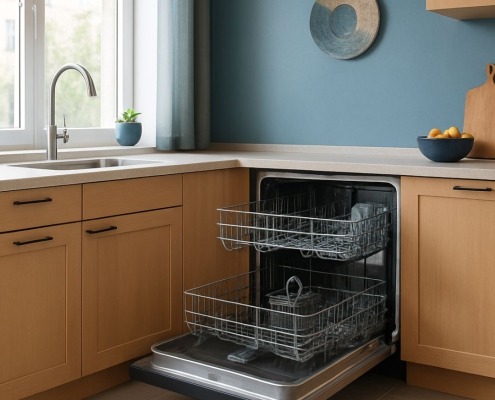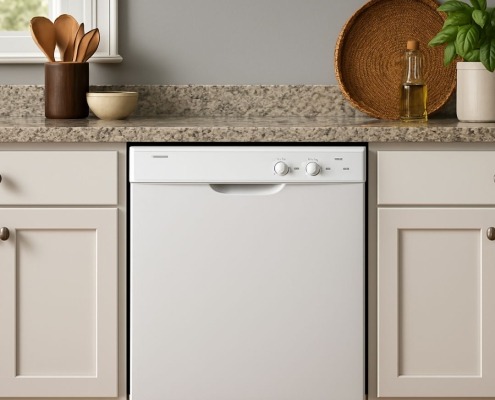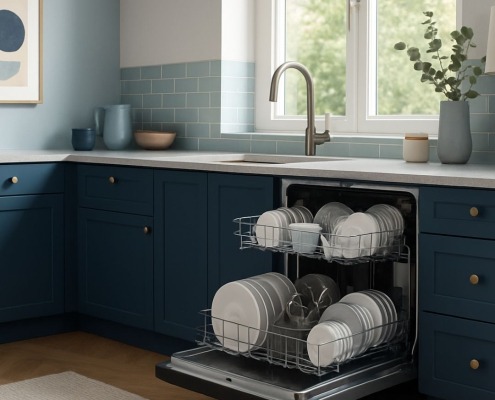How to replace a Samsung dishwasher heating element
Steven E / Monday April 21, 2025
On a Samsung dishwasher, the heating element is responsible for heating the water during the wash cycle, allowing your dishwasher to effectively clean and sanitize your dishes.
Common signs that indicate the need for replacement include the dishes not drying properly, the water not reaching the desired temperature, and visible damage or corrosion on the heating element.
You can find a replacement heating element DD47-00008A here. If you need other replacement parts for your Samsung dishwasher, just enter your model number at AppliancePartsPros.com to find them. It’s that easy! Most orders arrive in just two business days, and we have thousands of guides to show you how to install your new parts.
The information in this article may not apply to your specific appliance model. We recommend consulting your manufacturer’s documentation or contact us with any questions.
Tools
- Replacement part (make sure it’s compatible with your model before installing)
- Phillips screwdriver
- Flathead screwdriver
- 5/8 in wrench
- 9/64 in hex screwdriver
- Pliers
- Towels
Safety precautions
When working on any appliance, remember to keep safety first. Here are some tips to keep in mind:
- Always power off and unplug your appliance or switch off the circuit breaker before attempting any maintenance or replacement work. This keeps you safe by preventing any risk of injury from electric shock.
- Turn off the water supply at the outlet before beginning repairs to any appliance parts that hold water. Have towels ready for any residual water in the system when removing parts.
- Wear insulated work gloves to protect your hands from sharp metal parts, pinching hazards and debris.
- Don’t test wiring with a multimeter for live voltage if you’re unfamiliar with how to prevent short circuiting when testing.
- When working with wires, avoid touching any exposed wires or terminals. If you need to touch a wire, use a non-conductive tool or wear insulating gloves to prevent electrical shock.
- Take your time and don’t rush while working to prevent accidents and personal injuries.
- Work in a well-lit area so you can clearly see and access the interior parts.
- Clear your workspace of clutter and other obstacles. Keep children and pets away from the work area.
- Never work on internal parts with bare wet hands. Make sure the work area is completely dry.
- Check your user manual to see if there are specific installation or safety instructions for your part or appliance.
- Be gentle when handling or removing parts. Excessive force might damage the appliance or cause injury.
- Wear safety glasses when working with chemicals, dust or cleaning large debris to prevent injury.
- If the appliance has recently been used, give it plenty of time for any heating parts to cool down before working on it.
- Take pictures or make a note of wiring terminals or other connections before disconnecting to prevent any problems with reassembly.
Replacement steps
Step 1: disassembly
- Turn off the power to the dishwasher at the circuit breaker and shut off the water supply valve.
- Open the dishwasher door and remove both upper and lower racks.
- Remove the mounting brackets for the water supply tube assembly on the top and rear of the dishwasher tub. Rotate the tube to release it from the pump assembly.
- Pull the wash arm up to detach it from the pump assembly.
- Use a Phillips-head screwdriver to remove the screws securing the pump cover. Lift off the pump cover.
- Use a phillips-head screwdriver to remove the screws securing the lower access panel, and carefully remove the panel.
- Use a 5/8th inch wrench to unthread the water supply line connected to the inlet valve at the bottom of the dishwasher. Have a towel ready for any remaining water when disconnecting the line.
- Remove the screws securing the junction box cover located near the water supply line and pull the cover off.
- Take note of the location of the wires connected inside the junction box. Untwist the wire nuts to disconnect the wires.
- Detach the strain relief nut from the junction box.
- Disconnect the drain hose from the sink drain or garbage disposal and feed it through the cabinet.
- Open the dishwasher door and Use a phillips-head screwdriver to remove the cabinet mounting bracket screws on the top or sides of the door frame.
- If necessary, adjust the dishwasher’s legs to lower the appliance.
- Carefully pull the dishwasher away from the cabinet, making sure to avoid any damage to the cabinet and floor.
- Tip the dishwasher back so it rests on its rear panel.
- Remove the mounting screws securing the main control board cover. Remove the cover and use a small flat-head screwdriver to pry out the control board housing and move it out of the way.
- Remove the screws securing the inner access panel. Release the mounting tabs, detach the door wire conduit, and lift out the panel.
- Use the Phillips-head screwdriver to unthread the screws securing the bottom access panel. Pull the panel forward, disconnect the leak sensor wire connector, and set the panel aside.
- Use needle-nose pliers to detach the wires connected to the heater.
- Remove the screw securing the grounding wire to the heater bracket. Use a 10mm socket or nut driver to unthread the nut securing the heater mounting plate. Pull the plate free.
- Return the dishwasher to its upright position.
- Open the dishwasher door and remove the old heater.
Step 2: reassembly
- Install the new heater by positioning it in the pump housing.
- Tip the dishwasher back and align the heater mounting plate. Thread the nut onto the plate to secure the heater.
- Secure the grounding wire with the screw.
- Attach the wires to the terminals on the new heater.
- Reconnect the leak sensor wire connector.
- Reposition the bottom access panel on the base and snap the retaining tabs into place. Rethread the screws to secure it.
- Realign the inner access panel, snap the wire conduit into place on the panel, and hook the mounting tabs on the hinge supports. Replace the screws to secure the panel.
- Realign the main control board housing tabs with the slots in the base and push the assembly into position. Realign the cover and replace the screws to secure it.
- Return the dishwasher to its upright position.
- Gently slide the dishwasher back into the cabinet, taking care not to pinch any hoses or wires.
- Adjust the leveling legs if necessary to ensure the dishwasher is level and stable. Once adjusted, replace the screws to secure the mounting brackets to the cabinet or countertop.
- Feed the drain hose through the cabinet and connect it to the sink drain or disposer. Make sure that the hose is elevated above the connection point to prevent backflow.
- Position the wire strain relief in the junction box and secure it by threading the strain relief nut.
- Connect the wires using the wire nuts, align the junction box cover, and replace the screw to secure it.
- Reconnect the water supply line to the dishwasher’s inlet valve.
- Replace the lower access panel and secure it with the screws.
- Reposition the pump cover and replace all the screws to secure it.
- Realign the lower wash arm on the pump housing and snap it into place.
- Reinsert the bottom of the water supply tube into the pump assembly and rotate it to secure it. Snap the tube into the mounting brackets on the rear and top of the dishwasher tub.
- Reinstall the upper and lower dish racks.
- Turn the water supply and power back on at the circuit breaker.
- Run a test to check for any problems.
Additional information
Thanks for reading! We hope this guide helped you replace the heating element on your Samsung dishwasher.
If you still need some replacement parts, grab your model number and head over to AppliancePartsPros.com. We offer over two million parts and most orders arrive in two business days. If you need some help with finding the right part or placing an order, you can contact our team at 1 (877) 477-7278.
While you’re waiting for your new part to arrive, you can explore our DIY blog and watch thousands of video tutorials on our YouTube channel.
Be sure to follow us on Facebook, Twitter and Instagram to see our latest repair guides!
With nearly a decade of experience in providing top-notch customer service regarding appliance parts and repair, Steven enjoys sharing practical advice, troubleshooting tips, and interesting information to help readers stay informed.





